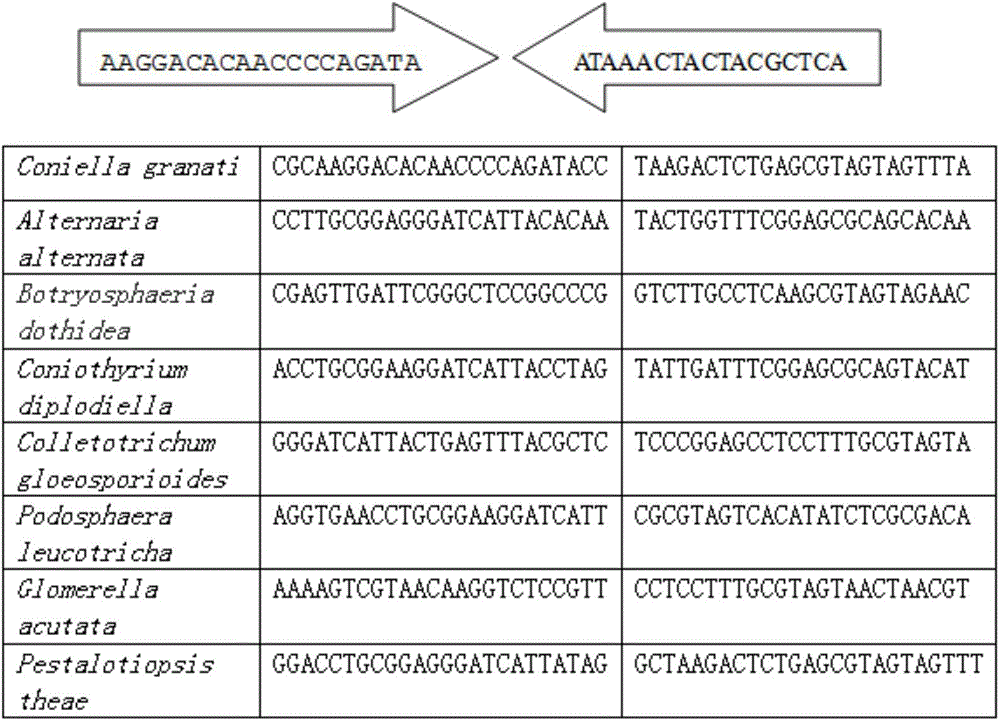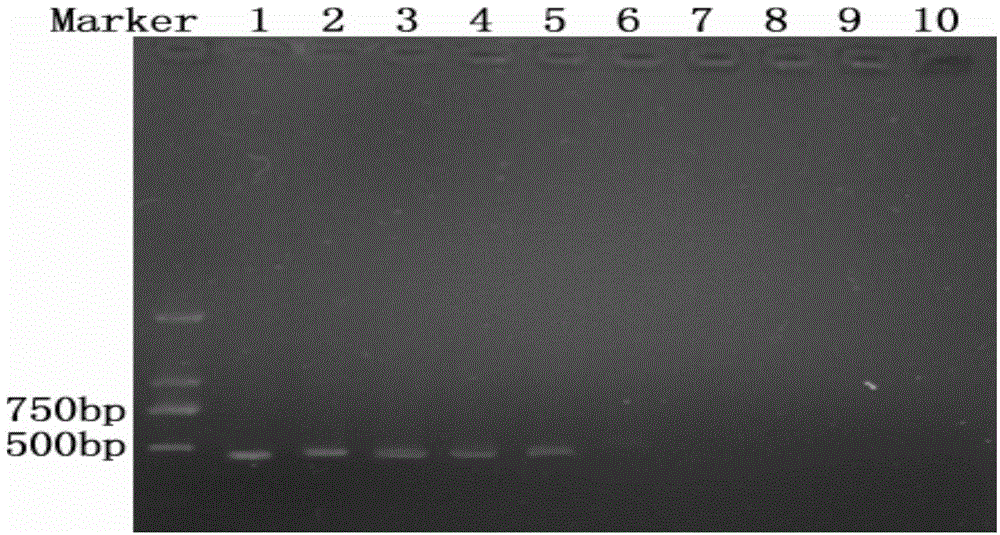Primer for detecting pomegranate dry-rot germs and detection method for detecting pomegranate dry-rot germs by using primer
A pomegranate dry rot pathogen and primer sequence technology, applied in biochemical equipment and methods, microbe measurement/inspection, DNA/RNA fragments, etc., can solve difficult pathogenic bacteria and affect the accurate isolation of pathogenic bacteria, etc.
- Summary
- Abstract
- Description
- Claims
- Application Information
AI Technical Summary
Problems solved by technology
Method used
Image
Examples
Embodiment 1
[0022] Embodiment 1: design, synthesize primer and set up the PCR reaction system of pomegranate dry rot pathogen
[0023] 1. Primer design and synthesis
[0024] Design of specific primers: After analyzing the rDNA-ITS sequences of Coniella granati and other genera in GeneBank, a pair of specific primers were designed with the following sequences:
[0025] S1: AAGGACACAACCCCAGATAC
[0026] S2: ATAAACTACTACGCTCAGAG. The designed primers were re-analyzed by BLAST in GeneBank to verify their specificity.
[0027] At the same time, a pair of phytopathogenic fungal ITS general primers ITS1 and ITS4 were used as outer primers for nested PCR, and the sequences were as follows:
[0028] ITS1: TCCGTAGGTGAACCTGCGG
[0029] ITS4: TCCTCCGCTTATTGATATGC
[0030] All primers were commissioned to be synthesized by Shanghai Sangong Synthesis Department.
[0031] 2. Establish a conventional PCR reaction system
[0032] Conventional PCR amplification system is: 10×Taq buffer 2.5μL, 25mmo...
Embodiment 2
[0035] Embodiment 2: Preparation of DNA template
[0036] Extract DNA from various samples as templates for PCR reactions. The specific process is as follows:
[0037] 1. Mycelium cultivation, collection and DNA extraction
[0038] PDA medium: 20g agar powder, 200g potatoes, 20g glucose, add water to 1L. Transfer the test bacteria to the PDA medium plate, culture in the dark at 20°C for 5 days, cut 10 pieces of 2cm × 2cm colony pieces from the edge of the colony, transfer to the PDA liquid medium, shake and culture at 28°C for 7 days, collect the mycelia by filtration, and Freeze in liquid nitrogen and grind into powder, and store at -20°C for later use.
[0039] Genomic DNA was extracted according to the CTAB method provided by molecular cloning, and the specific operations were as follows:
[0040]Take a small amount of mycelium powder, add 900 μL 2% CTAB extract and 90 μL 10% SDS, vortex and mix well, place in a water bath at 60°C for 1 hour, during this period, turn it ...
Embodiment 3
[0043] Example 3: Detection of specificity and sensitivity of primers
[0044] 1. Specificity detection See Table 1 for the bacterial strains used in the present invention and related information. Adopt the specific primer designed by the present invention to carry out PCR amplification to all test bacterial strain genomic DNAs in table 1, can only specifically amplify a 450bp band from Coniella granati bacterial strain, and other test bacterial strains and blank There was no amplified band in the control. It indicated that the primer had species specificity and could distinguish Coniella granati from other species.
[0045] Table 1 is used for screening the bacterial strain of primer specificity in the present embodiment
[0046] strain
Number of strains
Amplify results with S1 / S2
Coniella granati
1
+
Alternaria alternata
2
-
Botryosphaeria dothidea
2
-
Botrytis cinerea
2
-
Coniothyrium dipl...
PUM
 Login to View More
Login to View More Abstract
Description
Claims
Application Information
 Login to View More
Login to View More - R&D
- Intellectual Property
- Life Sciences
- Materials
- Tech Scout
- Unparalleled Data Quality
- Higher Quality Content
- 60% Fewer Hallucinations
Browse by: Latest US Patents, China's latest patents, Technical Efficacy Thesaurus, Application Domain, Technology Topic, Popular Technical Reports.
© 2025 PatSnap. All rights reserved.Legal|Privacy policy|Modern Slavery Act Transparency Statement|Sitemap|About US| Contact US: help@patsnap.com



